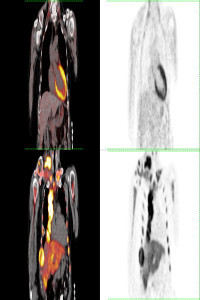Coincident Pelvic Uptake in the F-18 FDG PET/CT Imaging in Patients With the Diagnosis of Breast Carcinoma
Coincident Pelvic Uptake in the F-18 FDG PET/CT Imaging in Patients With the Diagnosis of Breast Carcinoma
Breast carcinoma, Gynecologic, FDG PET/CT,
___
- 1. Ishimori, T., Patel, P. V., & Wahl, R. L. (2005). Detection of unexpected additional primary malignancies with PET/CT. Journal of nuclear medicine : official publication, Society of Nuclear Medicine, 46(5), 752–757.
- 2. Agress, H., Jr, & Cooper, B. Z. (2004). Detection of clinically unexpected malignant and premalignant tumors with whole-body FDG PET: histopathologic comparison. Radiology, 230(2), 417–422. https://doi.org/10.1148/radiol.2302021685
- 3. Wooster, R., & Weber, B. L. (2003). Breast and ovarian cancer. The New England journal of medicine, 348(23), 2339–2347. https://doi.org/10.1056/NEJMra012284
- 4. Lerman H, Metser U, Grisaru D, Fishman A, Lievshitz G, Even-Sapir E. Normal and abnormal 18F-FDG endometrial and ovarian uptake in pre- and postmenopausal patients: assessment by PET/CT. J Nucl Med. 2004;45:266–71.
- 5. Park, S. A., Lee, K. M., Choi, U., Kim, H. S., Kim, H. W., & Song, J. H. (2010). Normal Physiologic and Benign Foci with F-18 FDG Avidity on PET/CT in Patients with Breast Cancer. Nuclear medicine and molecular imaging, 44(4), 282–289. https://doi.org/10.1007/s13139-010-0055-7
- 6. Razia, S., Nakayama, K., Tsukao, M., Nakamura, K., Ishikawa, M., Ishibashi, T., Ishikawa, N., Sanuki, K., Yamashita, H., Ono, R., Hossain, M. M., Minamoto, T., & Kyo, S. (2017). Metastasis of breast cancer to an endometrial polyp, the cervix and a leiomyoma: A case report and review of the literature. Oncology letters, 14(4), 4585–4592. https://doi.org/10.3892/ol.2017.6822
- 7. Akhtar, A., Ratra, A., Puckett, Y., Sheikh, A. B., & Ronaghan, C. A. (2017). Synchronous Uterine Metastases from Breast Cancer: Case Study and Literature Review. Cureus, 9(11), e1840. https://doi.org/10.7759/cureus.1840
- 8. Abrams HL, Spiro R and Goldstein N. Metastases in carcinoma: Analysis of 1000 autopside cases. Cancer 1950;3:74-85
- 9. Lee, J. W., Lee, J. H., Cho, A., Yun, M., Lee, J. D., Kim, Y. T., & Kang, W. J. (2015). The performance of contrast-enhanced FDG PET/CT for the differential diagnosis of unexpected ovarian mass lesions in patients with nongynecologic cancer. Clinical nuclear medicine, 40(2), 97–102. https://doi.org/10.1097/RLU.0000000000000667
- 10. Jeffry, L., Kerrou, K., Camatte, S., Metzger, U., Lelièvre, L., Talbot, J. N., & Lecuru, F. (2004). Endometriosis with FDG uptake on PET. European journal of obstetrics, gynecology, and reproductive biology, 117(2), 236–239. https://doi.org/10.1016/j.ejogrb.2004.04.034
- 11. Ames, J., Blodgett, T., & Meltzer, C. (2005). 18F-FDG uptake in an ovary containing a hemorrhagic corpus luteal cyst: false-positive PET/CT in a patient with cervical carcinoma. AJR. American journal of roentgenology, 185(4), 1057–1059. https://doi.org/10.2214/AJR.04.1282
- 12. Su, H. M., Hu, C., Tsay, D. G., & Peng, N. J. (2011). Ovarian thecoma mimicking carcinoma on F-18 FDG PET in a postmenopausal woman with elevated CA-125. Clinical nuclear medicine, 36(12), 1133–1134. https://doi.org/10.1097/RLU.0b013e3182335e57
- 13. Takeda, T., Sagae, S., Koizumi, M., Terasawa, K., Ishioka, S., Takashima, S., & Kudo, R. (1995). Multiple primary malignancies in patients with gynecologic cancer. International journal of gynecological cancer : official journal of the International Gynecological Cancer Society, 5(1), 34–39. https://doi.org/10.1046/j.1525-1438.1995.05010034.x
- 14. Babacan, N. A., Aksoy, S., Cetin, B., Ozdemir, N. Y., Benekli, M., Uyeturk, U., Ali Kaplan, M., Kos, T., Karaca, H., Oksuzoglu, B., Zengin, N., & Buyukberber, S. (2012). Multiple primary malignant neoplasms: multi-center results from Turkey. Journal of B.U.ON. : official journal of the Balkan Union of Oncology, 17(4), 770–775
- 15. Plotcha M, Cholewinski W, Buchardt E, Cegla P, Urbanski B, Warenczok-Florczak Z, et al. Strategy and early results of treatment of advanced cervical cancer. Gynocologica Polska 2017;88:475-80.
- Başlangıç: 2021
- Yayıncı: Mersin Üniversitesi
Abdominal Mass shown by the FDG PET/CT with diagnosis of Burkitt Lymphoma
Gökçe YAVAN, Zehra Pınar KOÇ, Pınar Pelin ÖZCAN
Pınar Pelin ÖZCAN, Zehra Pınar KOÇ, Vehbi ERÇOLAK, Zeynep Selcan SAĞLAM, Gökçe YAVAN, Murat BOZLU, Mesut TEK, Erdem AKBAY
Zehra Pınar KOÇ, Pınar Pelin ÖZCAN, Nurdan ORUÇOĞLU, Hamide SAYAR
Zehra Pınar KOÇ, Pınar Pelin ÖZCAN, Emel SEZER, Ahmet DAĞ, Ferah TUNCEL DALOĞLU, Tolgay Tuyan İLHAN
